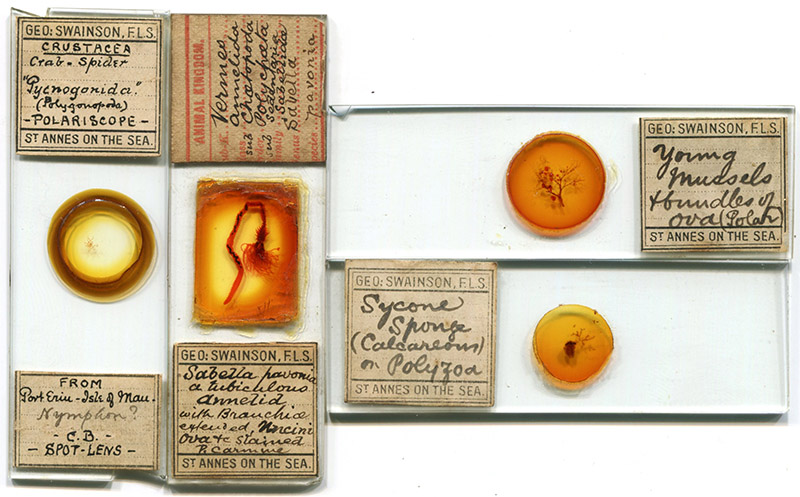
Figure 1. Slides with custom-made labels, printed with “Geo. Swainson, F.L.S.” (“Fellow of the Linnean Society”) and “St. Anne’s on the Sea”.
George Swainson, 1840 - 1909
by Brian Stevenson
last updated July, 2020
After moving to the Isle of Man in the mid-1880s, George Swainson became an avid naturalist and microscopist, with a particular interest in the zoophytes that lived in the surrounding sea. He joined the Linnean Society of London in 1887. He also joined the Wesley Naturalists' Society at about the same time, and later served as its President. Swainson was a prolific writer on aquatic animal life.
Swainson traded slides with fellow zoologists and microscopists, but the majority of those encountered nowadays probably came from his personal collection. Many appear to be preparations that were made for his studies, showing details that would be useful for scientific investigation. Some have customized labels with Swainson’s name and address of St. Anne’s on the Sea. The slides shown in Figures 1-3 were all acquired together, probably a part of Swainson’s collection, and include a slide that was customized by his son, and another that was purchased from a professional slide-maker.

Figure 1.
Slides with custom-made labels, printed with “Geo. Swainson, F.L.S.” (“Fellow of the Linnean Society”) and “St. Anne’s on the Sea”.
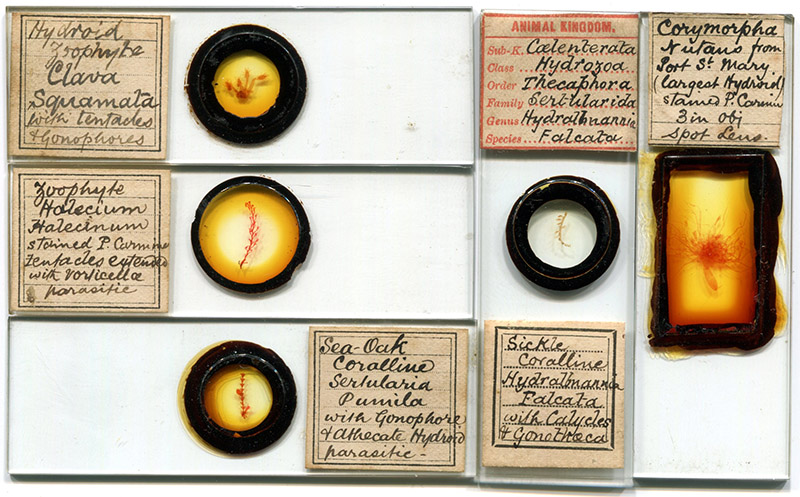
Figure 2.
Slides by George Swainson with off-the-shelf labels. These were acquired along with the slides shown in Figure 2, and the handwriting confirms that Swainson made them.
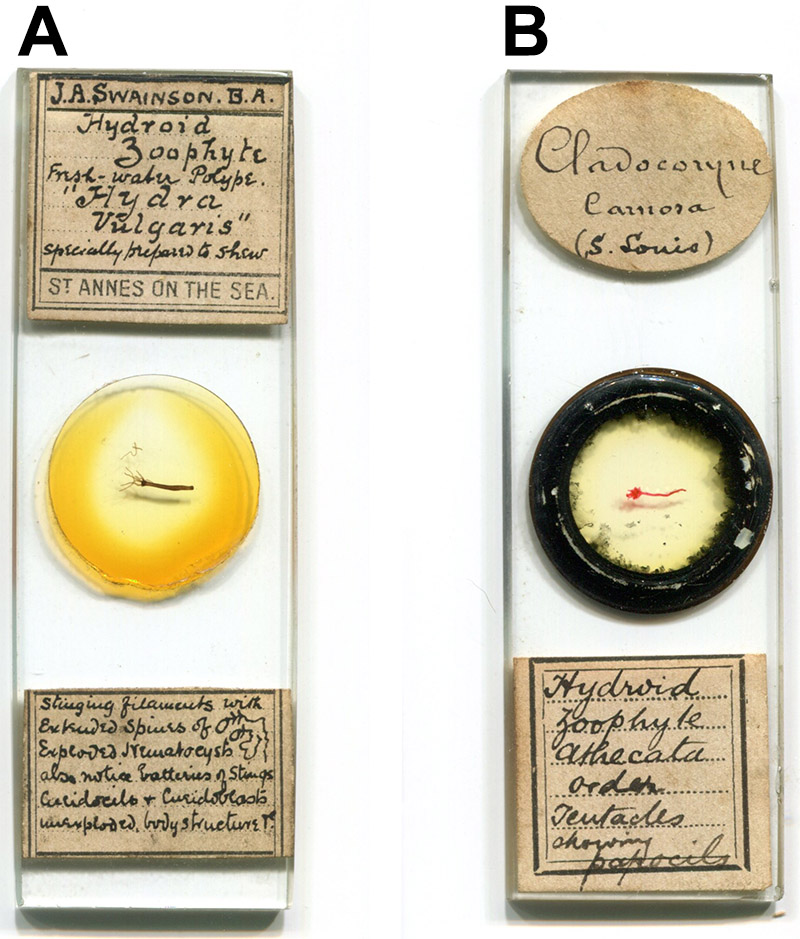
Figure 3.
(A) George Swainson slide that was re-touched by his son John Albert Swainson (1868-1948), who glued a piece of paper with his own name on top of his father’s.
(B) A microscope slide that was purchased from professional slide-maker J.C. Tempère (a.k.a. “S. Louis”), with a descriptive label added by George Swainson.

Figure 4.
“Sea oak coralline Sertularia pumila with gonophore & athecate hydra parasite”, prepared by George Swainson (see Figure 2). Photographed with a 3.5x objective lens and C-mounted digital SLR camera.
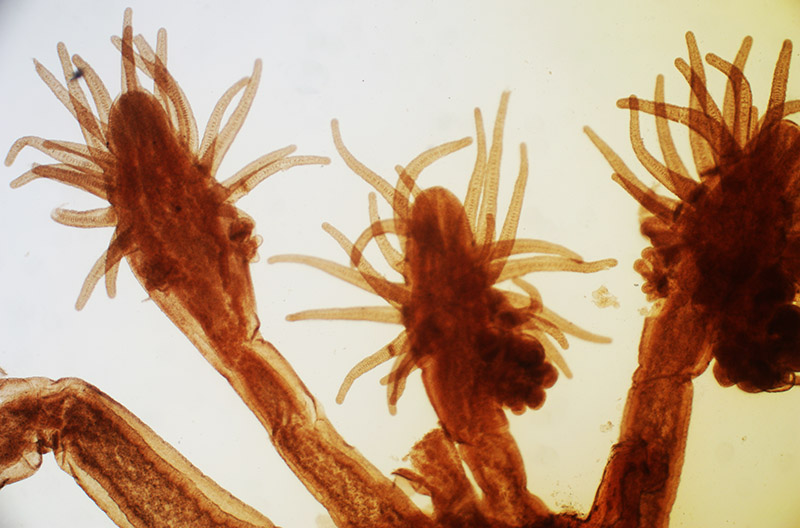
Figure 5.
“Hydroid zoophyte Clava squamata with tentacles & gonophores”, prepared by George Swainson (see Figure 2). Photographed with a 3.5x objective lens and C-mounted digital SLR camera.
George Swainson was born on July 20, 1840, in Ulverston, Lancashire. His father, John, who worked as a “clerk”, died in 1847. The 1851 national census shows that George’s mother, Ann, had found work as a “milliner”, and his 14 year-old sister, Elizabeth, was working as a “servant”. The family was also boarding a lodger to help meet expenses.
George learned accountancy. The 1861 census found the 20 year-old working as a clerk for a solicitor in Carleton, some 55 miles / 90 km away from his birthplace. At the time of his 1867 marriage to Martha Ramsbottom, he was an accountant in Accrington. Within a year, they had moved to Harrowgate, Yorkshire, where their first child, John, was born.
Soon afterward, the Swainson family moved to Huddersfield, Yorkshire, where George was employed as the accountant for the borough. Around 1876, they moved to Bolton, Lancashire, with George becoming the treasurer of that borough. He retained that job even after he had moved to the Isle of Man, retiring just before he died in 1909.
Swainson was elected to membership in the Linnean Society of London on December 1, 1887. It is likely that he had moved to St. Anne by the Sea, on the Isle of Man, by that time. Throughout 1887, Swainson published articles on sponges and other aquatic life in The Wesley Naturalist. On March 12, 1888, Swainson volunteered to the Wesley Naturalists' Society that he would “act as Director and Referee for a week's excursion to the Isle of Man in order to study its Animal Biology”. The following descriptions of that excursion imply that Swainson was well-acquainted with the Isle of Man at that time (noting also that the postal address given for Swainson was his business address):
“Excursion to the Isle of Man. Arrangements are being made for an excursion to the Isle of Man, for the purpose of studying the natural history of the western portion of the Island. Members of the Wesley Scientific Society only will be eligible to join the party. It is proposed to take the week from August 18th to 25th. Attention will be mainly directed to marine and shore zoology, under the direction of George Swainson, Esq., F.L.S., but it is hoped that the Rev. W. Spiers, M.A., F.G.S., &c., will be able to attend as Referee for Geology, and either the Rev. H. Friend, F.L.S., or F.T. Law, Esq., F.R.M.S. for Botany. A comfortable home at a country house on the shore will be provided, and the cost for board, lodging, boats, &c., will be about five shillings per day. As the number which can be accommodated must necessarily be limited, members must please apply at once to G. Swainson, Esq., F.L.S., Town Hall, Bolton, indicating what days they will be likely to spend at the home provided, and stating also whether they will be able to bring a microscope with them”.
“Excursion to the Isle of Man. The tour referred to in our last number took place at the time appointed and some dozen members of the Wesley Scientific Society spent a week together for the purpose of studying the natural history of the Isle of Man. The general arrangements were generously undertaken by our esteemed Referee George Swainson Esq. F.L.S. of Bolton, and they were carried out by him with much enthusiasm. The home provided by him at a farm house near Dalby was not only economical but was most admirably adapted to the requirements of such a party - The main object of the expedition was to study marine zoology, but some attention was given to botany and geology. So far as Zoophytes, Sponges and Polyzoa were concerned, Mr. Swainson was able to impart all necessary information to the members of the party. Dr. Bousfield identified such marine worms as were obtained, Mr. Chopin gave special attention to Sea-anemones, while Mollusca, Seaweeds and Geology were left to the Rev. W. Spiers M.A.. In addition to these subjects, Mr. F.T. Law F.R.M.S. rendered valuable aid to the members in botanical identifications”.
An exchange request that was published in The Wesley Naturalist in early 1889 gave Swainson’s address as St. Ann’s on the Sea (Figure 8).
In an 1887 article to The Wesley Naturalist on “Animal life”, Swainson wrote, “Another very beautiful form of protozoa is the fresh water ‘Bell animalcule’ - Vorticella of which I shall be pleased to send living specimens for examination under microscope to those members of my section who wish for some, and will send me a small tube or homoeopathic globule bottle in box for safe transmission by post. The contractile vesicle and the ‘Cilia’ with which they lash the water can be plainly seen, and also the food vacuoles by adding a little powdered carmine to the water in the Zoophyte trough needed to examine these living forms”.
Among the many papers that Swainson published around this time were “Sponges: anatomy” (1887), “Saunterings along the coast” (1888), “Dredging off Puffin Island for the rosy feather-star” and “Sponge hunting on the Manx coast” (both 1889), “Among the sea-urchins” (1890), “Notes on marine and fresh water larvae of midges” (1893), and “Some curious aquatic larvae” (1894). An 1891 paper, “Apendicularia, with its ‘haus’”, described what appeared to be a new species of tunicate, which Swainson named Oikomikron mitrateton (now considered to be a species of Oikopleura).
Throughout much of his time in the Wesley Naturalists' Society, Swainson served as a “Referee” for several topics, including marine zoology and general animal biology (Figure 10). This meant that he was broadly knowledgeable in those subjects and could help members with queries.
Swainson was elected to be a Vice President of the Wesley Naturalists' Society in 1890, and became President by 1895.
George Swainson retired from his position as Treasurer of Bolton in 1909. He passed away on November 28 of that year, while in Bolton.
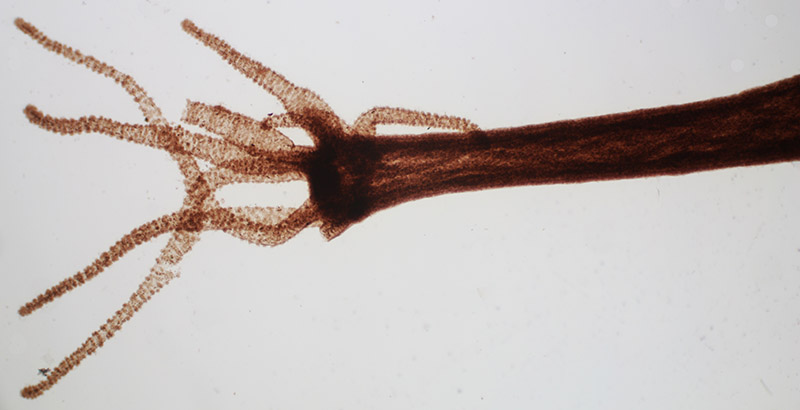
Figure 6.
“Hydroid zoophyte fresh water polyp Hydra vulgaris”, prepared by George Swainson (see Figure 3). Photographed with a 3.5x objective lens and C-mounted digital SLR camera.
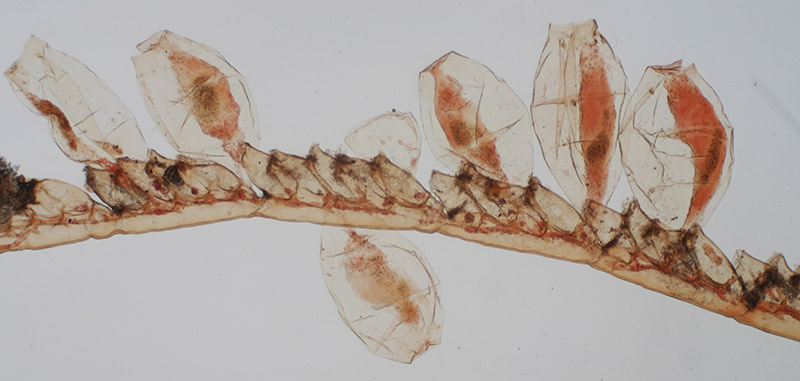
Figure 7.
“Sickle coralline Hydrallnannia falcata (true name: ‘Hydrallmania falcata”) with calycles and gonotheca”, prepared by George Swainson (see Figure 2). Photographed with a 3.5x objective lens and C-mounted digital SLR camera.

Figure 8.
Exchange offers from George Swainson.

Figure 9.
Illustrations by George Swainson that accompanied his 1887 paper on “Sponges”, from “The Wesley Naturalist”.
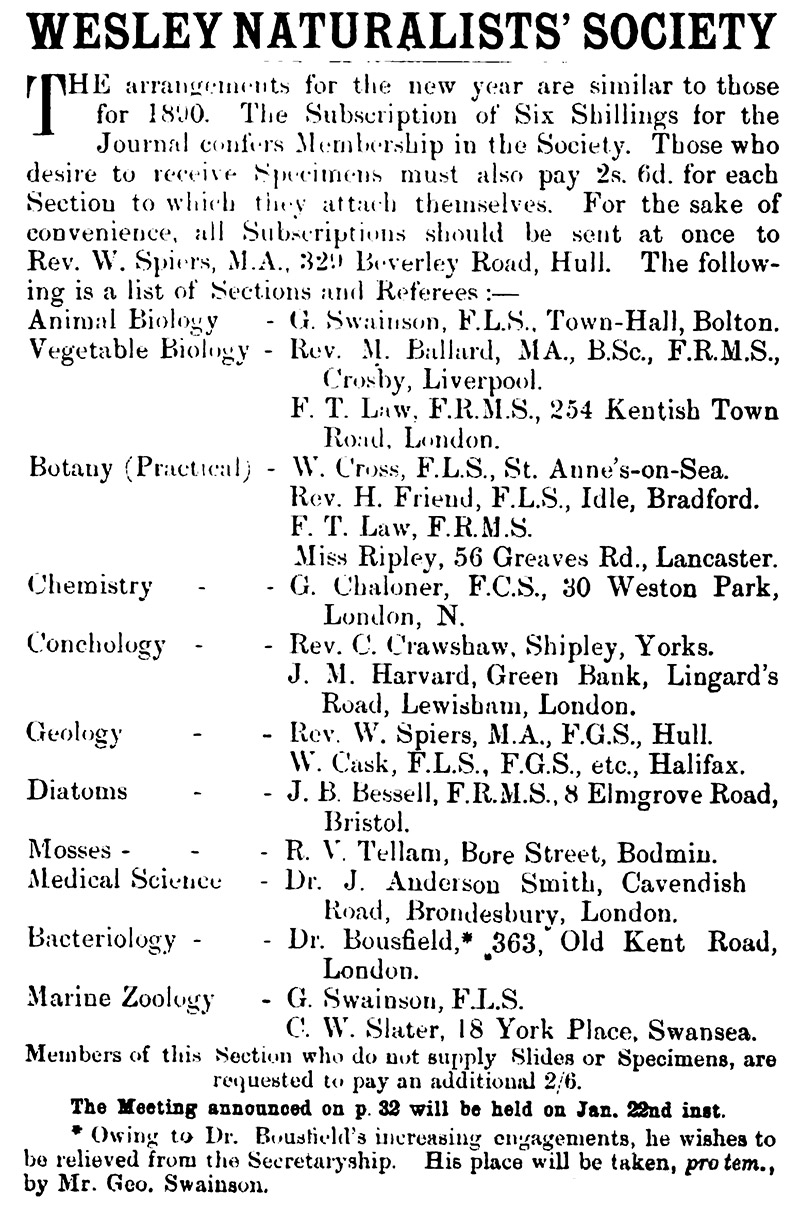
Figure 10.
One feature of the Wesley Naturalists’ Society, which had members spread throughout the United Kingdom, was volunteer “Referees” for the Society’s various sections, who made themselves available to members for advice and curated specimens for circulation. In 1891, George Swainson was the Referee for “Animal Biology” and “Marine Zoology”.
References
England census and other records, accessed through ancestry.com
Hardwicke's Science-Gossip (1890) Exchange offer from George Swainson, Vol. 26, page 48
The Journal of Microscopy and Natural Science (1890) Vol. 9, page 218
The Journal of Microscopy and Natural Science (1891) Exchange offer from George Swainson, Vol. 10, page 26
The Journal of Microscopy and Natural Science (1891) Wesley Naturalists’ Society, Vol. 10, rear of journal
Marriage record of George Swainson and Martha Ramsbottom (1867) Parish records of Whalley, Lancashire, accessed through ancestry.com
The Municipal Journal (1909) Bolton’s Borough Treasurer: Mr. Swainson’s resignation accepted, Vol. 18, page 162
Probate of the will of George Swainson (1909) “Swainson George of 28 Somerset-road Bolton Lancashire died 28 November 1909 Probate Manchester 18 March to John Alfred Swainson physician and surgeon and Annie Swainson spinster. Effects £4663 9s”, accessed through ancestry.com
Proceedings of the Linnean Society of London (1887) page 5
Proceedings of the Linnean Society of London (1895) “Members: 1887, Dec. 1, Swainson, George, Esq., Treasurer of the Borough of Bolton, Pres. Wesley Sci. Soc. St. George’s-road, St. Anne’s-on-Sea, Lancashire”
Proceedings of the Linnean Society of London (1910) “The following Fellows have withdrawn … George Swainson”, page 64
Swainson, George (1887) Animal life, The Wesley Naturalist, Vol. 1, pages 86-87
Swainson, George (1887) Hydra vulgaris and Hydra viridis, The Wesley Naturalist, Vol. 1, pages 129-131 and 257-260
Swainson, George (1887) Sponges, The Wesley Naturalist, Vol. 1, pages 148-149
Swainson, George (1887) Hydra vulgaris and Hydra viridis, The Wesley Naturalist, Vol. 1, pages 248-250
Swainson, George (1888) Hydroid zoophytes, The Wesley Naturalist, Vol. 1, pages 337-338
Swainson, George (1888) Alternation of generations, The Wesley Naturalist, Vol. 2, pages 4-7
Swainson, George (1888) Saunterings along the Coast, The Wesley Naturalist, Vol. 2, pages 203-205 and 231-234
Swainson, George (1888) On the Dalby Rocks - amongst the sea anemones, The Wesley Naturalist, Vol. 2, pages 262-267
Swainson, George (1889) Sponge hunting on the Manx coast, The Wesley Naturalist, Vol. 3, pages193-99
Swainson, George (1890) Among the sea-urchins, The Journal of Microscopy and Natural Science, Vol. 9, pages 9-18 and 260-268
Swainson, George (1891) Apendicularia, with its “haus”, The Journal of Microscopy and Natural Science, Vol. 10, pages 10-19
Swainson, George (1893) Notes on marine and fresh water larvae of midges, Science, Vol. 22, pages 107-108
Swainson, George (1894) Some curious aquatic larvae, British Naturalist, Vol. 6, pages 137-140
Swainson, George (1902) Bolton tramway depreciation, The Electrical Engineer, Vol. 30, page 559
The Wesley Naturalist (1887) Exchange offer from George Swainson, Vol. 1, page 288
The Wesley Naturalist (1888) Excursion to the Isle of Man, Vol. 2, pages 160 and 256
The Wesley Naturalist (1889) Exchange offer from George Swainson, Vol. 3, page 96